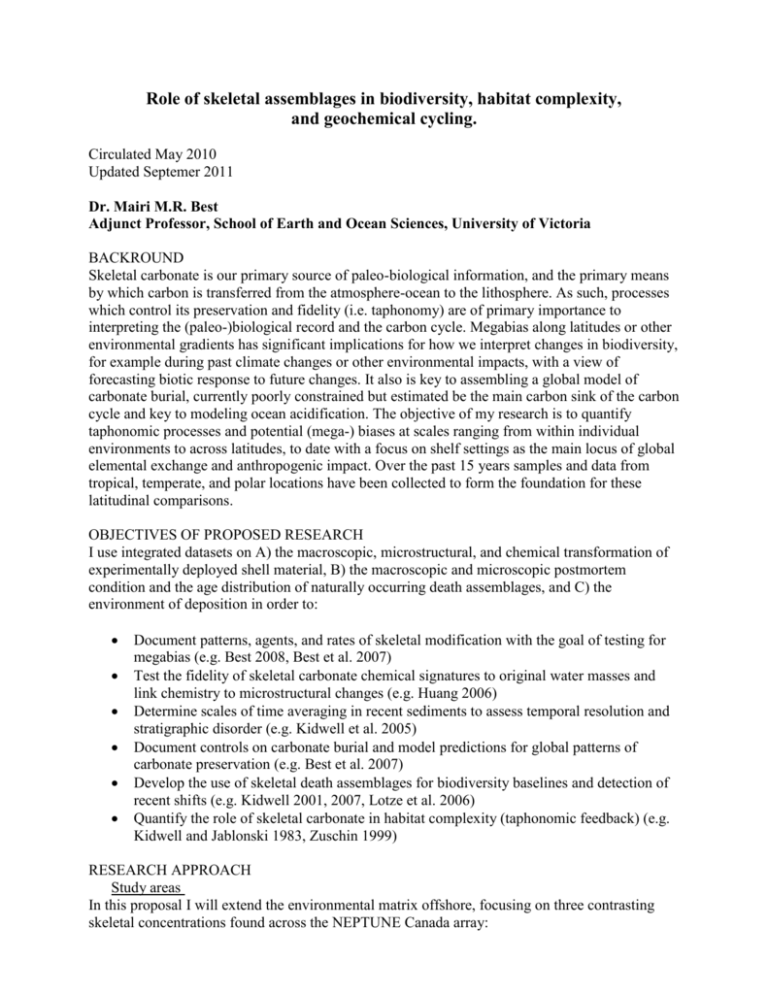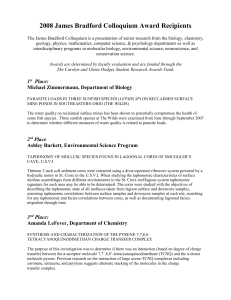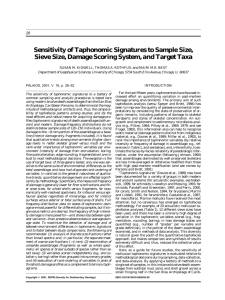Role of skeletal assemblages 2011
advertisement

Role of skeletal assemblages in biodiversity, habitat complexity, and geochemical cycling. Circulated May 2010 Updated Septemer 2011 Dr. Mairi M.R. Best Adjunct Professor, School of Earth and Ocean Sciences, University of Victoria BACKROUND Skeletal carbonate is our primary source of paleo-biological information, and the primary means by which carbon is transferred from the atmosphere-ocean to the lithosphere. As such, processes which control its preservation and fidelity (i.e. taphonomy) are of primary importance to interpreting the (paleo-)biological record and the carbon cycle. Megabias along latitudes or other environmental gradients has significant implications for how we interpret changes in biodiversity, for example during past climate changes or other environmental impacts, with a view of forecasting biotic response to future changes. It also is key to assembling a global model of carbonate burial, currently poorly constrained but estimated be the main carbon sink of the carbon cycle and key to modeling ocean acidification. The objective of my research is to quantify taphonomic processes and potential (mega-) biases at scales ranging from within individual environments to across latitudes, to date with a focus on shelf settings as the main locus of global elemental exchange and anthropogenic impact. Over the past 15 years samples and data from tropical, temperate, and polar locations have been collected to form the foundation for these latitudinal comparisons. OBJECTIVES OF PROPOSED RESEARCH I use integrated datasets on A) the macroscopic, microstructural, and chemical transformation of experimentally deployed shell material, B) the macroscopic and microscopic postmortem condition and the age distribution of naturally occurring death assemblages, and C) the environment of deposition in order to: Document patterns, agents, and rates of skeletal modification with the goal of testing for megabias (e.g. Best 2008, Best et al. 2007) Test the fidelity of skeletal carbonate chemical signatures to original water masses and link chemistry to microstructural changes (e.g. Huang 2006) Determine scales of time averaging in recent sediments to assess temporal resolution and stratigraphic disorder (e.g. Kidwell et al. 2005) Document controls on carbonate burial and model predictions for global patterns of carbonate preservation (e.g. Best et al. 2007) Develop the use of skeletal death assemblages for biodiversity baselines and detection of recent shifts (e.g. Kidwell 2001, 2007, Lotze et al. 2006) Quantify the role of skeletal carbonate in habitat complexity (taphonomic feedback) (e.g. Kidwell and Jablonski 1983, Zuschin 1999) RESEARCH APPROACH Study areas In this proposal I will extend the environmental matrix offshore, focusing on three contrasting skeletal concentrations found across the NEPTUNE Canada array: hardground and winnowed skeletal concentrations at Folger Pinnacle hydrate associated in situ skeletal concentrations at Barkley Hydrate (800m) talus skeletal concentrations of vent mussel shells at Endeavour (2100m) The following methods will be employed in these settings, along with the existing NEPTUNE Canada instrumentation: A) Macroscopic, microstructural, and chemical transformation of experimentally deployed skeletal material. Using consistent methodologies, previous experiments have been deployed at 27 sites, across 8 areas in tropical, temperate and polar latitudes, and a range of 1-150m water depth to constrain rates and pathways of taphonomic processes. Treatments allowed distinction among mineralogies and microstructures (using Mercenaria mercenaria and Mytilus edulis shells), 1)above, 2)at, and 3)below the sediment/water interface (1&3 are endmember treatments, 2 approximates natural burial/exhumation). Past periods of deployment were initially 1, 3, 5, 10, 15, and 20 years, however short-term (<1yr) deployments were added as rapid reactivity is detected in most environments, and VENUS deployments have started to confirm suspected processes in a hypoxic inlet. Appropriate replication is done at each level of the experimental design, and controls (matching valves) are prepared in the same manner then archived in the lab (>8000 shells to date). Retrieved shells will be re-photographed, re-weighed, and taphonomically assessed according to the following criteria (e.g. Best 2008): a) Macroscopic assessment – epibionts, endobionts, fine-scale surface alteration (by microstructural sector), discolouration, commissure alteration, and fragmentation; b) Microscopic assessment (ESEM, TEM) – microboring, maceration, dissolution, precipitation, composition of precipitates (EDS, XRD); c)chemical assessment – analysis of selected shells for changes in carbon and oxygen isotopic signatures during early burial. Multivariate statistical analysis (see below) on this taphonomic data is then used to correlate with the integrated death assemblage and environmental datasets. B) Macroscopic and microscopic postmortem condition of naturally occurring death assemblages Naturally occurring bivalve death assemblages are assessed for post-mortem modification, taxonomic distribution, and age since death across a broad range of temperate shelf environments. Surface sediment samples and shallow cores are sieved to extract dead shell material for analysis. Shell material is taxonomically identified, coded for mineralogy and microstructure, and then taphonomically assessed macroscopically and microscopically according to the criteria listed above for experimental shells (A). Taxonomic assemblage lists are compared with long-term living community data to assess live/dead resolution. Selected shells are dated using 14 C, 210Pb, and Amino-Acid Racemization techniques. C) The environment of deposition. Based on my work in the tropics and temperate latitudes, potential taphonomic agents may be separated into exposure factors along axes of nutrient concentrations and seasonality, water turbidity and stratification, and into burial factors along axes of Fe content, carbonate content, sedimentation rates, temperature, and seasonality of organic input. Environmental characterization has consisted of data on the overlying water, the sediment, and benthic community (e.g. Best et al. 2007, Best 2008). Within and across these regions, contrasts in burial rate and benthic activity, in particular will be used to test their control on taphonomic condition. This inclusion of a coordinated environmental dataset has been key to interpretation of my taphonomic analyses to date and is particularly powerful in the context of NC associated data. D) Data Analysis Data from both natural death assemblages and experimental shell arrays, integrated with data on environmental and taxonomic controls, allow the ranking of importance of taphonomic agents. In all of the above, analysis of the data will be conducted using bivariate and multivariate methods, including continued development of techniques such as multidimensional scaling, bootstrapping, permutation tests, and logistic regression for application to taphonomic data (Best 2008, Kidwell et al 2005). PROPOSED EXPERIMENTS AND SAMPLING I propose to deploy freshly cleaned, photographed, weighed, and numbered Mytilus edulis shells at the Barkley Hydrate site if time permits during the September 2011 cruise. This will not require significant additional dive time (<30min). They will be within range of the benthic crawler, which will provide the means to make regular taphonomic observations and measure associated environmental data. This has been discussed previously with members of the Barkley Hydrate team (Chapman, Thomsen, Juniper). During the June 2011 NC workshop, ideas for experiments at the Barkley hydrate site expanded to encompass interest in the use of cellulose in deep sea environments by both bacteria and macrofauna (http://wiki.neptunecanada.ca/display/workshop/Microbial+and+Benthic+Planning). Both the shell and wood specimens will be studied by a team including those interested in taphonomic processes (Mairi Best, Anne Raymond, Karla Parsons), acidification processes (Laurenz Thomsen, Mairi Best, ...), and biotic recruitment to biological substrates (Kesen Ma, Casey Hubert, Laurenz Thomsen, Anna Metaxas, Kim Juniper, Nadine LeBris...). Figure 1. Experimental shell array at Barkley Hydrate. A total of two experimental arrays are proposed for September 2011 – one would be deployed at the hydrate mound, close to marker 9 but so that Wally can approach the specimens without going over the clam bed. The other should be placed well away from any mounds along Wally's Walk, say around marker 16. The arrays will be similar to the shell array retrieved during dive 1432 (see Figure 1-3), using the same frame, but with both shell and wood specimen strings. Figure 2. Experimental shell array being deployed at Barkley Hydrate. Figure 3. Experimental shell array attached to front porch of ROPOS. Experimental arrays are also proposed at a later date for the Folger shallow frame, and adjacent to the MEF camera at Endeavour, but require further design and consultation with scientific teams in those areas. NEPTUNE Canada cameras permit tracking of taphonomic processes realtime, with data on macroscopic changes retrieved daily-weekly. Pilot death assemblage samples for these sites were collected in 2008 in collaboration with K. Juniper, and have been analysed in my lab. Further replicate death assemblage sampling will be needed, and will be coordinated with other benthic sampling. Associated NEPTUNE Canada instruments will be used to track turbidity, burial/exhumation, temperature fluctuations and other parameters as available at the sediment/water interface. Some Related Literature Best, M.M.R. 2008. Contrast in preservation of bivalve death assemblages in siliciclastic and carbonate tropical shelf settings. Palaios 23: 796–809. Best, M.M.R., Ku, T.C.W., Kidwell, S.M., and Walter, L.M. 2007. Carbonate preservation in shelf environments: Unexpected role of tropical siliciclastics. Journal of Geology, 115: 437456. Best, M.M.R. and Kidwell, S.M. 2000a. Bivalve taphonomy in tropical mixed siliciclasticcarbonate settings: I. Environmental variation in shell condition. Paleobiology 26(1):80-102. Best, M.M.R. and Kidwell, S.M. 2000b. Bivalve taphonomy in tropical mixed siliciclasticcarbonate settings: II. Effect of bivalve life habits and shell types. Paleobiology 26(1):103115. Bibeau, K. 2006. The Fossil Record as an Archive of Biological Information in Marine IceScoured Environments: Canadian Arctic Ocean. M.Sc. Thesis, Earth and Planetary Sciences, McGill University, 260pp. Huang, Z. 2006. Experimental Assessment of Early Diagenetic Change in Marine Bivalve Shells. M.Sc. Thesis, Earth and Planetary Sciences, McGill University, 143pp. Kidwell, S.M. 2007. Discordance between living and death assemblages as evidence for anthropogenic ecological change. Proc. Nat. Acad. Sci. USA 104(45): 17701-17706. Kidwell, S.M., Best, M.M.R., and Kaufman, D.S. 2005. Taphonomic tradeoffs in tropical marine death assemblages: Differential time-averaging, shell loss, and probable bias in siliciclastic versus carbonate facies. Geology 33(9): 729-732. Kidwell, S.M. 2002. Time-averaged molluscan death assemblages: palimpsets of richness, snapshots of abundance. Geology 30(9): 803-806. Kidwell, S.M., Rothfus, T., and Best, M.M.R., 2001. Sensitivity of taphonomic signatures to sample size, sieve size, damage scoring system, and target taxa. Palaios 16(1):26-52. Kidwell, S.M. 2001. Preservation of species abundance in marine death assemblages. Science 294: 1091- 1094. Kidwell SM, Jablonski D. 1983. Taphonomic feedback: ecological consequences of shell accumulation. In: Tevesz MJS, McCall PL (eds). Biotic interactions in Recent and fossil benthic communities: 195-248. New York: Plenum Press. Lotze, Heike K., Hunter S. Lenihan, Bruce J. Bourque, Roger H. Bradbury, Richard G. Cooke, Matthew C. Kay, Susan M. Kidwell, Michael X. Kirby, Charles H. Peterson, Jeremy B. C. Jackson. 2006. Depletion, Degradation, and Recovery Potential of Estuaries and Coastal Seas. Science Vol. 312. pp. 1806 – 1809 Martin, R.E., Goldstein, S.T., and Patterson, R.T. 1999. Taphonomy as an environmental science. Palaeogeography, Palaeoclimatology, Palaeoecology, 149:vii-viii. Ramsay, K., Kaiser, M.J., Richardson, C.A., Veale, L.O., and Brand, A.R. 2000. Can shell scars on dog cockles (Glycymeris glycymeris L.) be used as an indicator of fishing disturbance? Journal of Sea Research 43: 167-176. Zuschin, M. Stachowitsch, M. Pervesler, P & Kollmann, H. 1999. Structural features and taphonomic pathways of a high-biomass epifauna in the northern Gulf of Trieste, Adriatic Sea.- Lethaia 32, 299-317.






